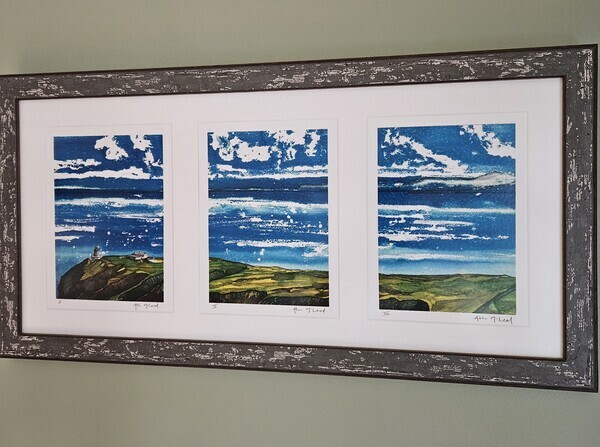In the news
On Saint Patrick's Day, I've been thinking back to a wonderful visit to Ireland with my husband a few years ago.I hadn't yet begun learning to paint, or even to sketch, although I was already taking photos with the intention of 'someday' painting them.
As lifelong art lovers and museum-hounds, our visit leaned heavily towards the arts. Similarly to Scotland, we quickly realized that this Celtic country's art and history are interwoven; visits to historic sites often also covered art history. With only a week overseas, we stayed in Dublin and took several day-trips to squeeze as much as we could into our short stay.
Most important to me was a guided coach (luxury tour bus) visit to Newgrange (Brú na Bóinne). Having visited the Skara Brae Neolithic village in the Orkney Isles, north of Scotland, we're both intrigued by these kinds of prehistoric sites.
Newgrange is a Neolithic passage tomb, dating to around 3200 BC, which makes it older than either the Egyptian pyramids or Stonehenge. Lonely Planet describes this UNESCO World Heritage Site as "one of the most remarkable prehistoric sites in Europe".
Not only is it an awe-inspiring construction, it's a monument to megalithic art; many of the stones within this site are engraved with intricate symbols, geometric patterns, spirals, and other carvings. The Entrance Stone alone is a marvel of overlaid spirals and diamond or square designs.
According to UNESCO, Newgrange is "Europe's largest and most important concentration of prehistoric megalithic art."
Back in Dublin, one of my "life dreams" came true when we viewed the Scottish Book of Kells at Trinity College. Written and illuminated on the Isle of Iona, off the western coast of Scotland in the 800s, this famous tome was apparently taken to Ireland to protect it from Viking raiders - but was never returned. My Scottish grandmother was very clear in her stories, when I was a child, that I should someday visit Ireland to see this "Scottish treasure".
What I hadn't realized was that the "Book of Kells is primarily a piece of artwork", with absolutely stunning illustrations.
We visited a number of other museums combining the arts and history of Ireland: the Chester Beatty; Dublin City Hall Art Gallery; Dublinia; Dublin City Gallery - The Hugh Lane (including Francis Bacon's studio); An Post (GPO) Museum; Irish Whiskey Museum; Jeanie Johnston Tall Ship Museum; National Gallery of Ireland; National Museum of Ireland - Archaeology; and National Museum of Ireland - Decorative Arts & History (housed in the 1700s Collins Barracks).
One sunny day we took a train trip out to the picturesque harbour village of Howth. From there, we enjoyed a boat tour to see the Howth Cliffs and the uninhabited - and oddly named - Ireland's Eye island. This rocky isle is a nesting site for many species of seabirds, including gorgeous puffins. After a self-guided walking tour of the historic harbour and village, we took a 7 km coastal cliff walk along Howth Head.
We maintained our tradition of bringing back an artistic souvenir, a more meaningful memento than food or drink (although we did bring some goodies back as well!). While visiting the harbour, we toured Alan McLeod's West Pier Art Studio and fell in love with this triptych. We brought home a limited edition numbered print of the Bailey Lighthouse Triptych, which now resides in our living room. A little bit of Ireland, and a lot of good memories, in this artwork in our Canadian home.
